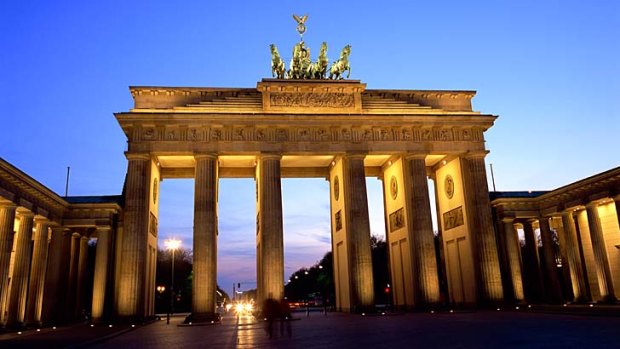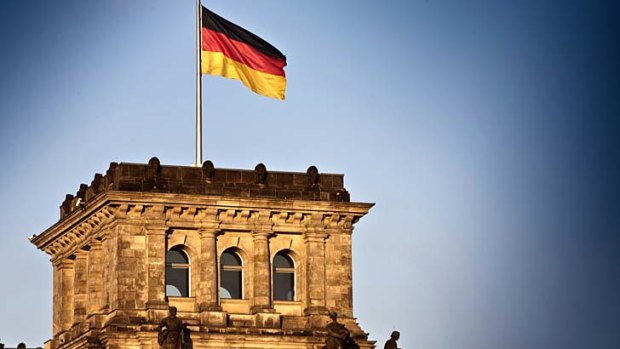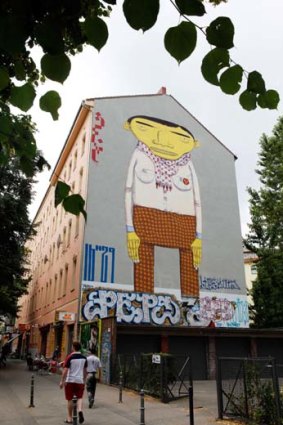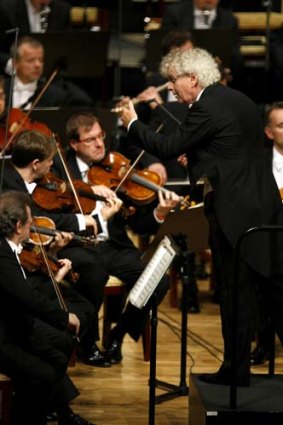
The symbol of Berlin ... Brandenburg Gate.Credit: AFP
1 The Story of Berlin
The German capital has an excellent collection of museums that cover specific periods of the city's history, but The Story of Berlin is the only one that covers Berlin from its days as a marshy backwater to the present. The presentation is superb, from the use of atmospheric sound to theatre set-style rooms for different eras. It's the sort of place where you constantly find yourself saying, "I never knew that". www.story-of-berlin.de.
2 The Berlin Wall

Home of the German Parliament ... the Reichstag.Credit: Getty Images
It may have been torn down in November 1989, but the Berlin Wall has left its mark on Berlin's character. Some parts remain standing and the stretch along Bernauer Strasse has become an open-air museum, the Mauerpark. The stories of communities being arbitrarily divided are staggering and you get a real impression of how the wall was laid out. It wasn't just one wall - it was two, divided by a "death strip" that no one could enter. It's worth getting there via the Nordbahnhof railway station, which has display panels that show how the wall was extended to underground railway tunnels. There are some excellent tales of escape attempts, too.
3 Underground tours
The Gesundbrunnen underground station is the best bet for illustrations of Cold War paranoia, however. Behind locked doors is a network of nuclear shelters, emergency infirmaries and grim-looking dorms. If a nuclear bomb had been dropped on West Berlin, this was where people would have had to cram into - and the underground station would have been sealed. Berliner Unterwelten runs superb, illuminating tours. berliner-unterwelten.de.

A mural Berlin's Kreuzberg district.Credit: AFP
4 Ostalgie
Some East Berliners pine for the old communist days, with the most obvious symbol of this nostalgia for East Germany being the Ampelmann. The jaunty green man from the traffic lights has restaurants and souvenir shops based on him. The best spot to dip into the "Ostalgie" wave, however, is the DDR Museum. It presents a somewhat glossed-over view of life in communist-controlled East Germany, showing the shabby imitations of Western products and clothing that East Berliners put up with. It also touches on a huge network of informers created by the secret police, the Stasi, and suggests that the German love of nudity was a reaction to the tightly controlled society. ddr-museum.de.
5 Badeschiff

Sir Simon Rattle conducts the Berlin Philharmonic Orchestra.Credit: AFP
If it's unflustered nudity you're after, then this utterly bizarre swimming pool/sauna/bar is full of it. The cocoon-like building sits on the River Spree and acts as a giant skinny-dipping arena. The pool is odd enough, but the people sitting naked on the bar stools are a bit more disconcerting. arena-berlin.de/index.php/badeschiff.
6 Nightlife
Berlin is not a sedate city and nights can last as long as you want them to. Some of the edgier clubs in Friedrichshain are arrive-Friday-evening-leave-Sunday-afternoon affairs, but numerous areas are suited to carefree bar-hopping. Northern Neukolln is where the too-cool-for-school crowd can be found; Kreuzberg is where they have moved on from, leaving a great buzz with less attitude. Oranienburger Strasse has long been abandoned to the tourists, but it's still fun for a cheap cocktail crawl.
7 Brewing renaissance
Germany is famous for its beer, and most of the good ones come from Bavaria. A few Berlin brewers are trying to change that, and have opened bars to sell their own products. Try Eschenbrau near Wedding station, the Schoppebrau beers at Bier Kombinat Kreuzberg, and Brewbaker's somewhat experimental range in the Arminiushalle. eschenbraeu.de, bier-kombinat.de, brewbaker.de.
8 Doner kebabs
And to help those beers go down? It has to be one of Berlin's contributions to the world of junk food. Currywurst - chopped sausage attacked with curry powder - is rightly famous only in Berlin. The doner kebab, however, has gone worldwide. It was invented in 1971 by Turkish immigrant Mahmut Aygun at his Hasir restaurant in Kreuzberg. Hasir is still open, although kebab quality across the city is almost universally good. hasir.de.
9 The Brandenburg Gate
It's the symbol of Berlin, and an undeniably impressive one when you get close to it. But it has a more powerful impact when you understand its historic importance. The Quadriga - a giant statue of a goddess riding a four-horse chariot - was taken to Paris by Napoleon when he conquered the city. It's now back, pointedly looking out over the French embassy. But the recent history is more powerful. The gate somehow survived World War II, even though everything around it was levelled. When the wall went up, it was left in the death strip - the city's symbol, stranded where people on both sides could see it, but they could not touch it.
10 Bearpit karaoke
Every Sunday afternoon - weather permitting - Irish bike messenger Joe Hatchiban rocks up to the amphitheatre in the Mauerpark with his karaoke equipment. A thousand or so people then crowd round, fuelled by enterprising beer salesmen, to cheer on brave amateur singers. Quality of singing isn't a priority. Passion and willingness to shamelessly entertain are rewarded with the biggest cheers. bearpitkaraoke.com.
11 Museumsinsel
For culture of a more traditional nature, Museumsinsel (Museum Island) is Berlin's centrepiece. Five world-class museums are crammed onto the island. The Neues Museum and Pergamon Museum concentrate on archaeology, with superb Roman, Greek and Egyptian artefacts. For art, head to the Altes Museum, Alte Nationalgalerie and Bode Museum - all would be the star attraction in many cities.
12 Berlin Philharmonic Orchestra
Continuing along highbrow lines, the Berlin Philharmonic Orchestra is regarded by many as the best in the world. Conducted by wild-haired Brit Simon Rattle, semi-regular performances take place at the Philharmonie on the south side of the giant Tiergarten park. berliner-philharmoniker.de.
13 The Holocaust Memorial
Peter Eisenman's Holocaust Memorial has proved highly controversial in Berlin, partly because it takes up a huge amount of prime development land and partly because it doesn't seem to represent anything in particular. It's a large field of concrete blocks, no two the same size, that gradually get higher as you walk in. Architect Eisenman has deliberately never explained what the blocks are supposed to represent, but the feelings of claustrophobia and intimidation as you walk further seem appropriate. The metaphor of terror creeping up slowly and suddenly finding yourself in too deep seems appropriate.
14 Topographie des Terrors
If the walking tour doesn't hammer the horrors of Nazi Berlin home, then the Topographie des Terrors will. It stands on the site of the old Gestapo headquarters and offers an extraordinarily detailed account of the era. The key personalities of the regime are profiled, and the final section shows how disturbingly few of them were brought to justice. topographie.de.
15 Third Reich walking tours
You find out just how appropriate the feeling is on a walking tour of key sites from the Third Reich. Many have been taken down - Hitler's bunker lies under a nondescript car park and many of the pompous Nazi buildings were destroyed in World War II. Some - such as the old Luftwaffe HQ - still loom intimidatingly large, but context is the key to such tours. Berlin Walks employs knowledgable guides who manage to paint the picture beautifully. They help you realise that the Nazis were a product of the awful financial mess Germany was in at the time, and that they played by the rules on their way up the ladder to dictatorial power. berlinwalks.de.
16 The Reichstag
The home of the German Parliament is a key icon in the nation's history. The turning point in the Nazis' rise to power came when it was burnt down in 1933 - almost certainly at Hitler's request. Images of Soviet soldiers flying flags from the Reichstag were the iconic photos of the fall of Berlin in 1945. After German unification, the Reichstag was renovated. A stunning glass dome by Sir Norman Foster forms the highlight of tours of the building. The tours must be pre-booked. bundestag.de.
17 Street-art workshops
The company Alternative Berlin heads to the train yards as part of its street-art tours, but the really cool part comes back at its HQ. It teaches visitors the basics of street art, starting with stencils a wannabe Banksy would use, before letting them loose with spray paint. The guides running the classes try to demonstrate more complicated techniques, but everyone is encouraged to try their own ideas. alternativeberlin.com.
18 Murals
Berlin is arguably the street-art capital of the world at the moment, largely because the city authorities have given up in the battle against graffiti. There is plenty of lazy tagging around, but there are also hugely impressive murals on buildings across the city. Ambling through the districts of Friedrichshain and Kreuzberg is the best way to see some of the standouts. However, for a concentration, head to the abandoned train yards east of Warschauer Strasse station. A mishmash of bars, galleries, nightclubs and performance spaces has moved into the unloved buildings, and muralists from around the world have been allowed to do their thing.
19 Art hotels
The creative side isn't limited to the streets: Berlin is full of hotels with an artistic bent. The Arte Luise Kunsthotel is a beautiful example. The rooms are set around a leafy courtyard and each one acts as a gallery for the work of a different artist. The walls are covered in their paintings, and the artist gets a royalty payment as part of the room rate. luise-berlin.com.
20 Accommodation bargains
If cost rather than creativity is the key issue when picking a hotel, then you're in luck. By European standards, Berlin's hotels are absurdly cheap. Four stars can generally be found for as little as $50, and five stars tend to start about $115. It makes Berlin a brilliant spot for an extended stop on the European circuit.
The writer was a guest of Visit Berlin.
Sign up for the Traveller Deals newsletter
Get exclusive travel deals delivered straight to your inbox. Sign up now.